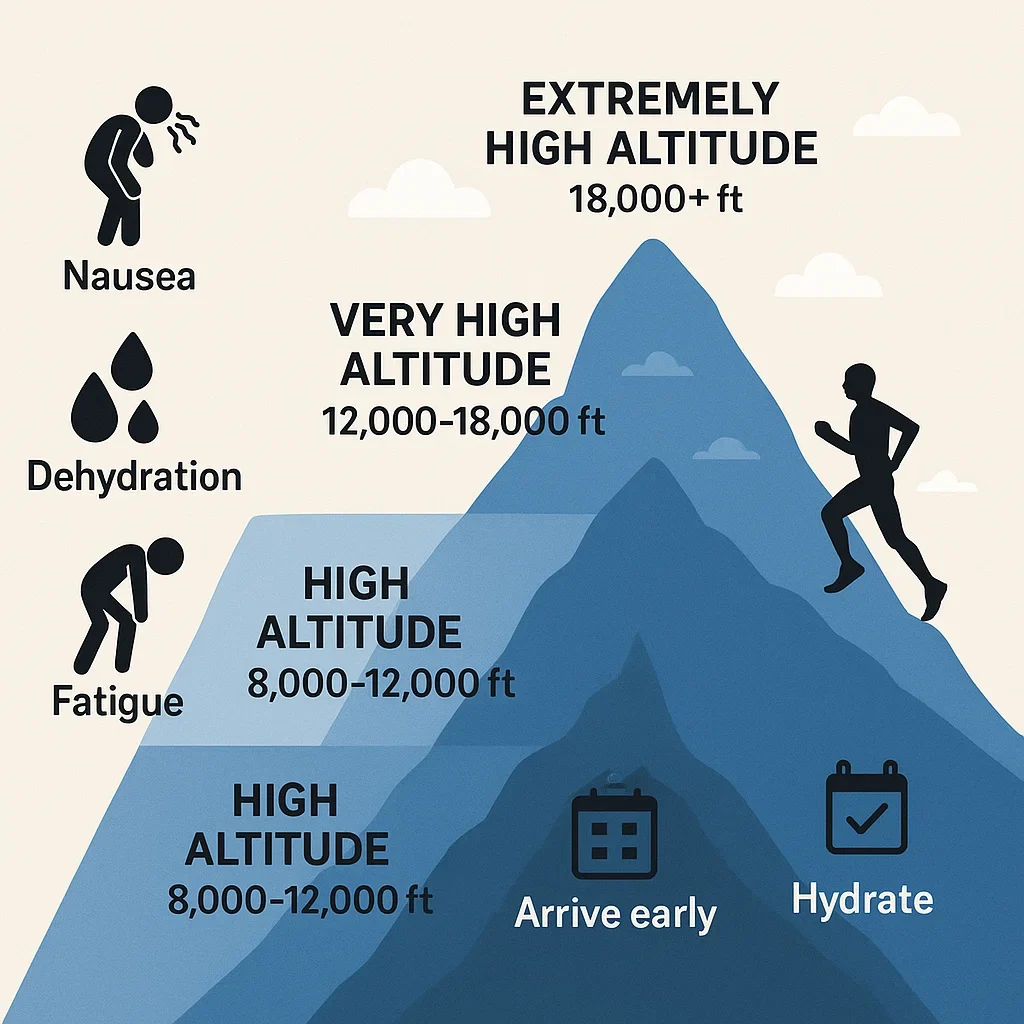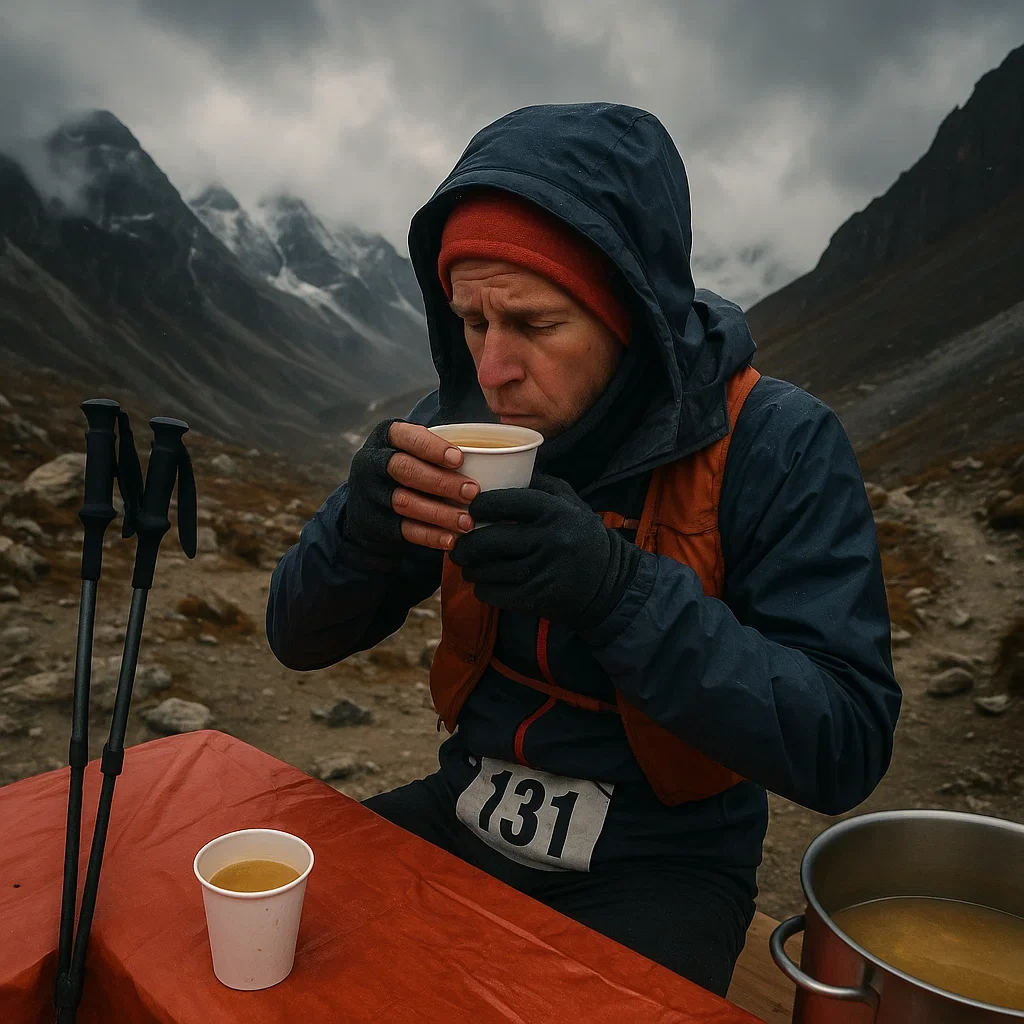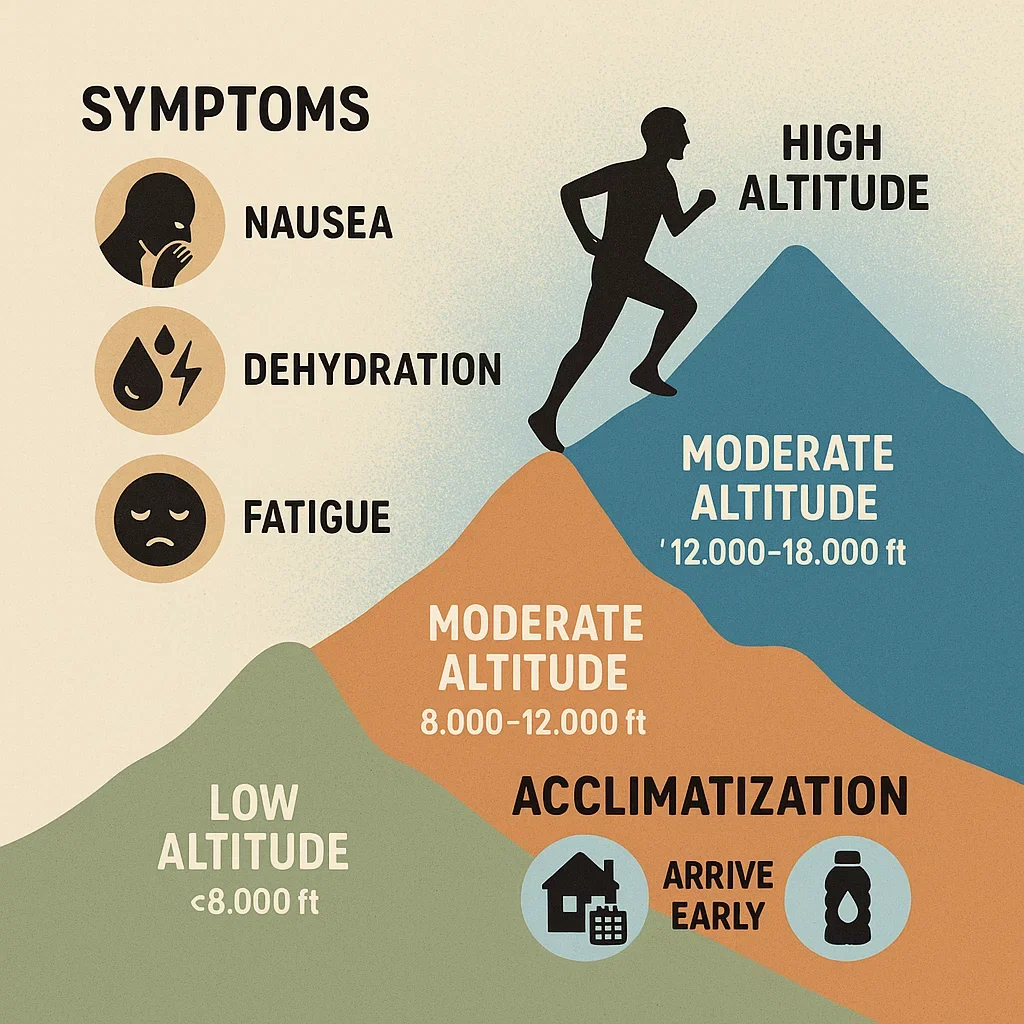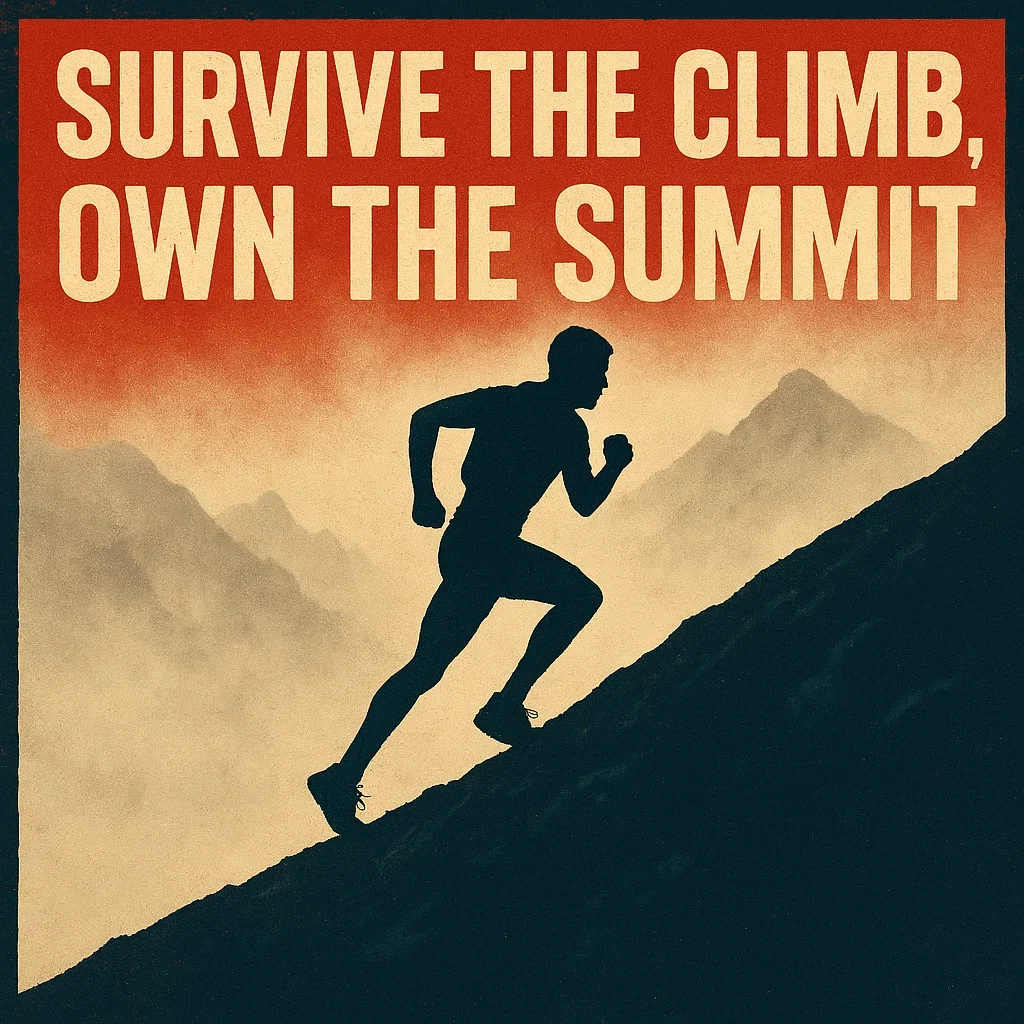Part 1: Altitude Acclimation – How to Breathe, Adapt, and Survive the Thin Air
High altitude doesn’t care how fit you are. 🧠🏃♂️ Once you climb past 2,500 meters (8,200 feet), your body enters unfamiliar territory — oxygen drops, dehydration kicks in faster, and your mind gets fuzzy. For ultrarunners planning to take on a mountain 100-miler like Hardrock 100, UTMB, or Leadville, acclimation isn’t optional — it’s your first survival skill.
🌬️ Why Altitude Hits Harder in a Mountain 100
You’re already running 100 miles. But doing that with less oxygen per breath? That’s like playing the game on “nightmare mode.”
At altitude:
- Oxygen availability drops by ~3% every 300 meters
- Your heart rate and breathing rate spike
- Nausea, insomnia, headaches, and altitude sickness risk rise
That’s why many runners who crush sea-level ultras suffer unexpectedly when tackling their first high-elevation race.
📈 Acclimation Timeline: What Works (and What’s Too Late)
⛰️ Ideal Strategy: Arrive 2–3 Weeks Early
This gives your red blood cell count time to increase, helping deliver oxygen more efficiently.
✅ Pro tip: The first 48 hours at altitude are the worst. If you can’t arrive early, some runners recommend arriving just the day before the race to “outrun” the worst symptoms — but it’s a gamble.
🛏️ Sleep High, Train Low (if possible)
If you’re training for a mountain ultra while living low, tools like altitude tents can simulate elevation during sleep. They aren’t cheap, but even 2–3 weeks of exposure can boost your adaptation.
🧪 How Long Does Acclimation Take?
- 24–48 hours: Lightheadedness, insomnia, headaches
- 4–7 days: Body begins adapting, but still vulnerable
- 10–14 days: Blood oxygen levels stabilize
- 21+ days: Full acclimation for most runners
💧 Hydration, Sunscreen & Electrolytes: Don’t Skip
High altitudes are dry and deceptive — you sweat more, urinate more, and still feel dry.
- 💦 Drink more than usual: Aim for 750–1000 ml/hour
- 🧂 Increase electrolytes: Especially sodium and magnesium
- 🧴 Use high-SPF sunscreen: UV exposure rises 10–12% per 1,000 meters gained
🎯 Quick Tip: Pee pale and frequently. Dark urine = dehydration. No exceptions at altitude.
🥄 Appetite Loss? Plan Easy Calories
Another sneaky challenge: you often don’t feel hungry.
- Bring high-calorie, low-volume snacks: nut butters, soft gels, soup packs
- Choose warm, salty foods at aid stations (broth, ramen)
💬 Motivation Box:
“Altitude doesn’t care how strong your legs are. It rewards patience, planning, and humility.”
🪨 Part 2: Climbing & Descending – Mastering the Terrain of Mountain Ultras
Running in the mountains isn’t about pace — it’s about power, control, and precision. 🧗♂️ Whether you’re grinding up 1,500 meters of gain or bombing down loose shale switchbacks, your success in a mountain 100-miler depends on how well you manage the vertical.
⛰️ Uphill Strategy: It’s Not About Running
Forget running. Most mountain ultras are about power hiking, not sprinting.
🔁 Cadence + Posture Tips:
- Keep short, rhythmic steps — don’t lunge.
- Lean slightly into the hill from the ankles, not the waist.
- Use your arms actively to drive momentum.
🥢 Trekking Poles: Love Them or Lose Time
- Take pressure off your legs by distributing effort to your upper body
- Great for long climbs and steep, technical terrain
- Practice beforehand — poles add efficiency but require skill
🔗 Internal Link Opportunity: [Uphill & Downhill Techniques for Mountain Ultras]
📉 Downhill Strategy: Stay Loose, Stay Alive
Downhill is where most runners either make up time or destroy their quads.
🦵 Key Techniques:
- Lean slightly forward, not back
- Keep knees soft and strides short & quick
- Don’t brake too hard — let gravity assist but stay in control
👣 Practice on Variety:
- Loose gravel
- Muddy switchbacks
- Technical descents with roots and rocks
🧠 Quick Tip: Think like water — flow around obstacles, don’t fight them.
🎯 Terrain Mindset: “Time on Feet” > “Pace per Mile”
In mountain races, splits are meaningless.
A 20-minute mile uphill might be a win. A 7-minute downhill could still be conservative.
So instead of tracking pace:
- Track segments (aid station to aid station)
- Use time targets, not distance targets
- Understand that mental fatigue can spike on relentless climbs
🧠 Mental Drill: Name Your Climbs
Give each major climb a name.
Assign it a mindset — like:
- “Calm Strength” for the first grind
- “Unbreakable Goat Mode” for the second
- “One with the Rock” for the brutal final ascent
Naming helps mentally separate the chaos and gives structure to suffering.
🧗♀️ Bonus Section: Training for Vert When You Live Flat
Not everyone has access to mountains. But you can simulate climbing with:
- Treadmill at 10–15% incline: power hike intervals (5 x 5 minutes)
- Stair workouts: long sets with a weighted vest
- Box step-ups: 3 x 20 reps per leg, low rest
And for downhill:
- Downhill treadmill (if available)
- Eccentric strength training (slow lowering squats, lunges)
- Practice technical trail descents on weekend getaways
🧠 Motivation Box:
“Climbing is where you find yourself. Descending is where you prove it.”

🌲 Part 3: Technical Trails & Mountain Weather – Surviving Nature’s Mood Swings
Running 100 miles is already brutal — add in ankle-breaking terrain, fog-drenched ridgelines, and a thunderstorm at 3,000 meters? Now you’re playing in the mountain gods’ arena.
Technical trails and unpredictable weather are what separate mountain ultras from normal 100-milers. And the key to surviving them? Preparation, adaptation, and respect.
🪨 Technical Terrain: Train Your Ankles & Mind
In a mountain ultra, you’re not just running — you’re navigating.
🦶 Terrain You’ll Likely Encounter:
- Loose scree & shale
- Rocky descents
- Root-ridden singletracks
- Narrow, exposed ridgelines
- Steep mud or snow crossings
🧠 How to Train:
- Trail specificity: Train on the most technical trails you can access
- Lateral agility drills: Side hops, single-leg balance, trail drills
- Core + ankle strength: Bosu ball, single-leg Romanian deadlifts, and proprioception work
🥢 Bonus tip: Practice with loaded packs and poles to mimic race-day mechanics.
⛈️ Mountain Weather: Four Seasons in One Race
You can start under blue skies and end in a freezing downpour.
Welcome to high-altitude chaos.
🎒 Always Pack:
- Lightweight waterproof jacket
- Insulating layer (fleece or merino)
- Gloves and a buff
- Emergency blanket or bivvy
🏁 Even in July, snowstorms happen in races like Hardrock 100 or Tor des Géants.
📦 Drop Bag Planning:
- Store extra warm/dry layers at high-elevation aid stations
- Pack sunscreen, electrolyte mix, and anti-chafing gear
🌦️ Decision Framework: “Do I Take the Jacket?”
Ask yourself:
- How exposed is the next section?
- What’s the wind forecast?
- How far to the next aid station?
- What if I had to stop for 30 mins — would I get cold?
If you hesitate → take the jacket. You’ll rarely regret it.
🧭 Trail Navigation & Visibility
Fog, hail, or night running can obscure markers. Get comfortable with:
- Course GPX on watch
- Reflective markers & headlamp practice
- Knowing when to stop & reassess vs. “just keep going”
🧠 Motivation Box:
“The trail doesn’t care how tough you are. But it will reward those who are ready for everything it throws their way.”
🥣 Part 4: Nutrition & Hydration at Altitude – Fueling When Your Body Says “No”
High altitude messes with more than just your lungs — it disrupts hunger, thirst, and digestion. Your stomach turns shy, your mouth dries out, and gels that worked at sea level suddenly feel like bricks.
But in a 100-mile mountain race, underfueling = DNF. Learning how to eat and drink above the clouds is survival.
🧠 Altitude & Appetite Suppression
Once you pass ~2,500m (8,200 ft), your body:
- Releases more catecholamines (stress hormones)
- Experiences slower gastric emptying
- Has decreased appetite, especially during hard efforts
You might feel full after 2 sips — but that’s a trap.
🚨 Your Fix:
- Eat small portions frequently: Every 30–40 minutes
- Use liquid calories when solid food is unappealing (tailwind, Maurten, soup, etc.)
- Pre-load calories before climbs, since digestion slows on uphills
💧 Hydration: Faster Loss, Slower Signals
At altitude, the air is dry and cool. You lose fluids quickly, but don’t feel thirsty.
🧂 Key Strategies:
- 750–1000 ml/hour fluid intake
- Electrolytes with every bottle (especially sodium and magnesium)
- Set a timer to sip every 10–15 minutes — don’t trust thirst
🥤 Include sodium-rich foods at aid stations: pickles, broth, salted potatoes
🔥 Hot Tip: Use Flavor Variety
Altitude + effort = palate fatigue. Sweet gels get old fast.
Bring:
- Savory options: rice balls, hummus wraps, soup
- Texture variety: crunchy vs. smooth
- Flavor switch every few hours (fruity > nutty > broth > sour)
🥄 What Real Runners Pack for Altitude Ultras
📦 Example fuel plan (per hour):
- 200–250 kcal (1 gel + small chew or half a bar)
- 500–750 ml water with electrolytes
- One “anchor food” every few hours (solid mini meal)
🎒 Pro ultrarunners recommend:
- Mashed potatoes in ziplocks
- Trail mix with chocolate + salt
- Caffeine carefully (only when digestion is steady)
🧠 Motivation Box:
“At altitude, your brain lies. Eat and drink anyway. Your finish depends on it.”

🧠 Part 5: The Mental Game & Cutoffs – Enduring When the Mountain Pushes Back
You’ve trained, fueled, and climbed your way into the high country… but now comes the hardest part: staying mentally present when everything hurts and the next aid station feels like a fantasy.
In mountain 100-milers, it’s not just the terrain that breaks runners — it’s the clock and mind games.
⏱️ Understanding Cutoffs in Mountain Ultras
Unlike flatter races, mountain ultras have:
- Lower overall finish rates (e.g., Hardrock: ~60–70%)
- Tighter intermediate cutoffs due to remote access and weather risk
- More time-on-feet fatigue (you’re out there longer)
Common cutoff scenarios:
- Hardrock 100: 48-hour limit, but multiple strict intermediate cutoffs
- UTMB: Generous total time, but relentless time checks every major climb
- Tor des Géants: 150+ hours but with elevation + sleep deprivation factors
🧠 Mental Strategies to Stay Ahead
🧩 1. Segment Everything
Break the race into mental “episodes”:
- Aid Station to Aid Station
- Climb to Climb
- Sunrise to Sunset
🎯 This creates manageable “chapters” in your story — instead of staring down 100 miles, you’re just moving through the next act.
🧠 2. Use Mental Anchors
Create emotional touchpoints you can return to when struggling:
- A phrase: “Stay grounded. Keep climbing.”
- A memory: A family member, a hard training day
- A visual: The summit, the sunrise, the finish chute
🔗 Consider linking to our Mindfulness for Endurance article here.
🥶 3. Prepare for the “Night Wall”
After sunset at altitude:
- It gets colder than expected
- Navigation slows down
- Your brain wants comfort, not progress
Use these tools:
- Hot drink at key aid stations
- Headlamp + backup battery tested in real trail runs
- Mantra loop for night (repeat a short, powerful phrase rhythmically)
🚨 Cutoff Panic Mode? How to React
If you’re approaching a cutoff:
- Stay calm — panic wastes time.
- Prioritize function over comfort (don’t change socks if unnecessary).
- Hike with purpose, not speed.
- Stick with others — group energy can lift the pace.
🧠 Mini Case Study: “Lessons from Leadville”
“I live at sea level. I reached the Twin Lakes aid station with just 8 minutes to spare. But I had pre-packed a ‘panic kit’ — caffeine gum, tailwind, and a motivational playlist. I hiked Powerline like my life depended on it. Made it with 90 seconds left.”
🎒 Takeaway: Mental drills + backup plans = survival at altitude.
🧠 Motivation Box:
“In the mountains, there’s no ‘easy mile.’ Only the next step. Take it.”

📥 Downloadable PDF: Mountain Ultra Survival Planner
✅ Your Step-by-Step Toolkit for Conquering Your First Mountain 100-Miler
What’s Inside the Planner
1. 🧗 Acclimation Timeline Checklist
Track what to do 3 weeks, 1 week, and 24 hours before your race to adapt to altitude. Includes:
- Arrival windows
- Altitude tent protocols
- Hydration reminders
- Sleep and sun exposure tips
2. 🎒 Gear Checklist for High Altitude & Technical Terrain
A printable, race-day packing guide with:
- Required gear (e.g., poles, layers, waterproofs)
- Emergency extras
- Night running must-haves
- “Fog, Cold, or Thunder?” Decision Matrix
3. 🥣 Fuel & Hydration Chart
Hourly fueling template designed for high elevation:
- 200–250 kcal/hour spacing
- Electrolyte reminders
- Foods for nausea or suppressed appetite
- Liquid calorie options
4. 🧭 Pacing & Segment Planner
Blank planner to track estimated splits by segment or climb, not just mileage. Includes:
- Aid station cutoffs
- “Mental Theme” per section
- Day/Night transition points
- Motivation triggers
5. ⏱️ Cutoff Checklist
Race-day cheat sheet to help you:
- React to cutoff pressure
- Prioritize what to do at each aid station
- Move efficiently without panic
- Use time-saving mental tricks
📌 Print it, fold it, or stash it in your drop bag. This planner is designed to keep you moving forward when the mountains try to stop you.
👉 Click here to download the printable PDF version
❓ Mountain Ultra Readiness Quiz
🏔️ Can you survive 100 miles of altitude, terrain, and time pressure? Let’s find out!
1️⃣ How long does it typically take to fully acclimate to high altitude (~2,500m+)?
A) 2–3 days
B) 4–7 days
C) 10–14 days
D) 21+ days
2️⃣ Which item is most critical to always carry on a mountain ultra, even in clear weather?
A) Energy gels
B) Rain jacket ☔
C) Sunglasses 🕶️
D) Trekking poles 🥢
3️⃣ What’s a common physiological response to high altitude running?
A) Excessive hunger 🍔
B) Slowed heart rate 🐢
C) Loss of appetite 😶
D) Decreased hydration needs 💧
4️⃣ What’s the safest downhill form on technical mountain terrain?
A) Long bounding strides 🐇
B) Lean slightly forward, soft knees 🧘
C) Heel strikes for braking 🚫
D) Quick stop-and-go pacing ⏱️
5️⃣ What’s a “mental segmentation” strategy in mountain ultras?
A) Dividing the race by aid stations or climbs 🧩
B) Ignoring terrain and focusing only on pace 📉
C) Pushing hard early to build a time buffer 🔥
D) Planning pace by weather forecast 🌤️
6️⃣ What’s the best hourly calorie intake target during a mountain 100-miler?
A) 80–120 kcal
B) 150–180 kcal
C) 200–250 kcal 🍯
D) 300–400 kcal
7️⃣ What’s the best response if you’re approaching a strict cutoff?
A) Panic and push 🤯
B) Calm down, minimize aid time, move efficiently 🧘♂️🚶
C) Ask volunteers to delay the cutoff 🙏
D) Take a long rest to regroup 🛏️
8️⃣ How can flatlanders prepare for mountain climbs?
A) Only run on roads 🛣️
B) Treadmill inclines and stair workouts 🧗♀️
C) Do only gym squats 🏋️
D) Daily sprints 🏃♂️💨
9️⃣ What’s a major risk of under-hydrating at altitude?
A) Faster hair loss 😅
B) Muscle growth inhibition ❌
C) Poor decisions + altitude sickness 🧠⚠️
D) Cramping only at night 😖🌙
🔟 What’s the biggest reason for DNF in high-altitude ultras?
A) Bad shoes 👟
B) Lack of electrolytes 🧂
C) Poor mental preparation and pacing 🧠⏳
D) Slow signup time 🐌
📘 Answers & Explanations – Mountain Ultra Readiness Quiz
1️⃣ Correct Answer: D) 21+ days
✅ Full acclimatization to high altitude typically takes 3 weeks or more. Early arrival is ideal; otherwise, consider altitude simulation tools.
2️⃣ Correct Answer: B) Rain jacket ☔
✅ Weather in the mountains can shift suddenly — even on sunny days. Hypothermia risk makes a rain jacket a must-carry item.
3️⃣ Correct Answer: C) Loss of appetite 😶
✅ At altitude, digestion slows and appetite decreases. Fueling becomes a discipline, not just hunger-driven.
4️⃣ Correct Answer: B) Lean slightly forward, soft knees 🧘
✅ This keeps your body balanced and reduces quad fatigue. Leaning back causes braking and injury risk.
5️⃣ Correct Answer: A) Dividing the race by aid stations or climbs 🧩
✅ Mental segmentation breaks a huge race into manageable chunks. This keeps focus and momentum alive.
6️⃣ Correct Answer: C) 200–250 kcal 🍯
✅ This is the gold standard for long ultras, balancing energy needs without overwhelming digestion — especially at altitude.
7️⃣ Correct Answer: B) Calm down, minimize aid time, move efficiently 🧘♂️🚶
✅ Cutoff panic leads to mistakes. Efficient forward motion saves more time than sprinting in a frenzy.
8️⃣ Correct Answer: B) Treadmill inclines and stair workouts 🧗♀️
✅ Simulated vertical training builds the same muscles and cardiovascular strength as real mountain work.
9️⃣ Correct Answer: C) Poor decisions + altitude sickness 🧠⚠️
✅ Dehydration impairs judgment and can trigger serious altitude-related illnesses like HAPE or AMS.
🔟 Correct Answer: C) Poor mental preparation and pacing 🧠⏳
✅ Mountain ultras demand patience and adaptability. Most DNFs happen not due to physical failure — but mental collapse or poor pacing early on.
🏁 Your Result Key:
- 9–10 correct: 🏔️ Mountain ultra master! You’re ready to toe the line.
- 7–8 correct: 🔋 Solid prep – just fine-tune your fueling and pacing.
- 5–6 correct: 🧭 You’ve got the basics – time to train the details.
- Below 5: 📝 Revisit the guide, grab the PDF, and get ready to climb smarter.
📚 Further Reading for Mountain Ultra Mastery
Build your complete mountain ultra toolkit with these trusted resources:
- 🧗♀️ Uphill & Downhill Techniques for Mountain Ultras
Master climbing efficiency and downhill control with proven drills. - 🎒 100-Mile Ultramarathon Gear Checklist (Ultralight Edition)
The definitive pack list for rugged, high-altitude races. - 🧠 Mental Strategies for Endurance
Build mental resilience with visualization, reset drills, and solitude training. - 🔁 Cross-Training for Trail Runners
Improve joint stability and trail endurance with smart cross-training techniques. - 🥣 How to Fuel for Technical Trail Ultras
Hydration, high-calorie fueling, and eating when you’re not hungry at altitude.
🌐 Trusted External Resources
- iRunFar: Altitude Training for Ultrarunners
- NIH: Nutritional Considerations for Ultra-Endurance
- Runner’s World UK: How to Train for Mountain Ultras
🙏 Special thanks to NIH, iRunFar, and Runner’s World for providing science-based insights that keep mountain runners safe, informed, and inspired.
❓ Frequently Asked Questions: Mountain 100-Miler Edition
1. How can I train for a mountain ultra if I live at sea level?
Use treadmill incline hikes, stair workouts, and simulated elevation training. Add hiking with a pack and weekend trail runs.
2. When should I arrive before a high-altitude race?
Ideally 2–3 weeks before. If not possible, arriving less than 24 hours before may blunt some acute symptoms, but it’s a risky strategy.
3. What is the biggest mistake first-timers make in mountain ultras?
Starting too fast. The effort feels light early due to cool air, but altitude fatigue hits later. Pacing conservatively is key.
4. What kind of shoes are best for a mountain ultra?
Trail shoes with aggressive grip, toe protection, secure lockdown, and rock plates are ideal for technical terrain.
5. Do I need trekking poles?
They’re optional but highly recommended for long climbs. Practice with them early. Most races allow them.
6. What’s the weather like during mountain 100-milers?
Unpredictable — expect sun, fog, wind, cold nights, rain, and even snow. Always carry a rain jacket and thermal layers.
7. What happens if I lose my appetite at altitude?
Use liquid calories, soft high-calorie snacks, and eat small amounts frequently. Never stop fueling completely.
8. How much should I drink per hour?
750–1000 ml/hour at altitude. Always include electrolytes to offset altitude-induced fluid loss.
9. How should I pace in a mountain ultra?
Forget pace-per-mile. Use “time on feet” per segment. Expect to hike climbs and jog downhills. Don’t chase sea-level pacing.
10. What’s the best way to avoid cutoff stress?
Segment the course mentally, move efficiently between aid stations, and avoid long breaks. Small gains add up.
11. How do I prevent blisters and foot issues?
Use gaiters, test socks in advance, lube your feet, and change socks if wet. Practice on technical terrain to toughen skin.
12. How cold can it get at night?
Even in summer, mountain nights can drop below freezing. Dress in layers and plan for extreme variation.
13. How do I manage navigation?
Load GPX files to your GPS watch. Practice using reflective markers and headlamps. Never blindly follow others.
14. Should I bring sunscreen and sunglasses?
Absolutely. UV intensity increases with altitude — protect your skin and eyes, especially in snow-exposed areas.
15. What nutrition works best for altitude?
Simple, soft, salty, and high-calorie options. Soup, mashed potatoes, tailwind, and nut butters are reliable staples.
16. How much vertical gain is “normal” in a mountain 100-miler?
Anywhere from 5,000 to 10,000+ meters (16,000–32,000 ft). Study the course profile closely and train accordingly.
17. What should I do if I feel dizzy or nauseated?
Slow down, hydrate, and eat something light. Sit if needed. If symptoms worsen, seek aid station support — altitude illness is real.
18. How do I stay motivated through long climbs?
Use mantras, name each section, break it into intervals, and think in “time effort” rather than distance. Every step counts.
19. Do I need a headlamp even if the race starts in daylight?
Yes. Mountain weather and cutoff delays mean you may finish in the dark. Always pack light and backup batteries.
20. Can I still finish if I’m not a strong climber?
Yes — if you pace wisely, fuel consistently, and train for long hours on your feet. It’s about resilience, not speed.
🚀 Ready to Conquer Your First Mountain 100-Miler?
✅ You’ve studied the terrain, mastered the altitude game, and packed your mental fuel — now it’s your turn to climb.
📥 Grab These Free Tools
- 🖨️ Mountain Ultra Survival Planner PDF – Download and print before your race!
- 🧠 Take the Quiz Again – Reassess your readiness after a few more weeks of training.
- 📆 Build Your Own Pacing Plan – (Coming soon!) A downloadable Google Sheet template.
📣 Spread the Mountain Ultra Spirit
- 💬 Share this guide with your crew, training partners, and mountain-minded friends
- 📌 Bookmark it and revisit during your race prep
- 🧭 Follow up with our upcoming Flatlander’s Mountain Plan (for those training low and racing high!)
👋 Got a question, feedback, or epic mountain story to share? Drop a comment below.
Let’s keep climbing — together. 🏔️

About the Author
Lost Pace is an ultramarathon runner, shoe-tester and the founder of umit.net. Based year-round in Türkiye’s rugged Kaçkar Mountains, he has logged 10,000 + km of technical trail running and completed multiple 50 K–100 K ultras.
Blending mountain grit with data, Lost analyses power (CP 300 W), HRV and nutrition to craft evidence-backed training plans. He has co-written 260 + long-form guides on footwear science, recovery and endurance nutrition, and is a regular beta-tester of AI-driven coaching tools.
When he isn’t chasing PRs or testing midsoles, you’ll find him sharing peer-reviewed research in plain English to help runners train smarter, stay healthier and finish stronger.
Ultrarunner · Data geek · Vegan athlete

